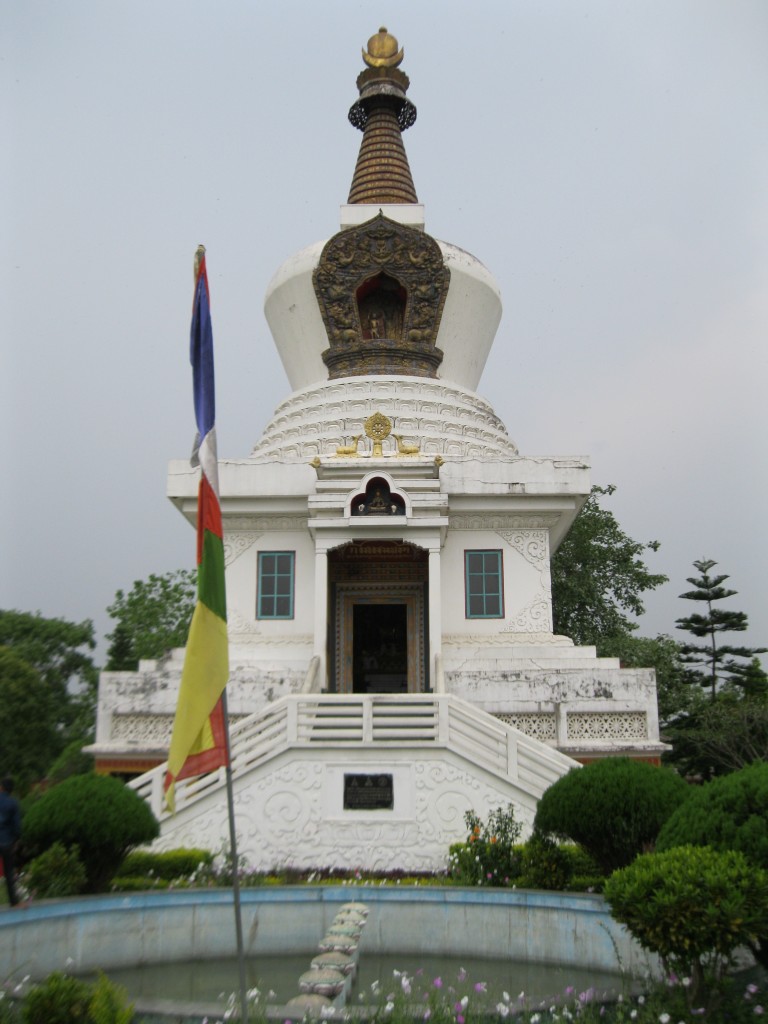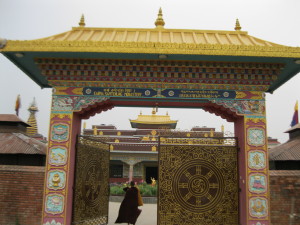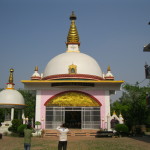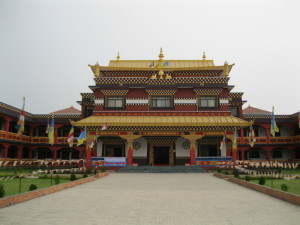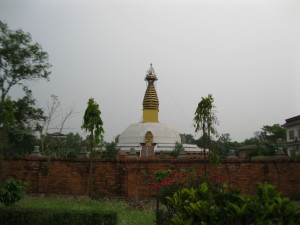An article by Bhikkhu Gunaratana on his trip to Lumbini in Nepal.
“I had been planning my trip to Nepal for the past two years when I was first invited to attend the opening ceremony of the International Monastic Buddhist Collage, located at the Sri Sumangala Vihara in Lalitpur, a suburb of Kathmandu.
“I arrived in Kathmandu around 9am on April 8th, 2015. The monk that invited me was at the airport waiting for me when I cleared customs taking me right away to the Vihara. During the short 20 minute drive from the airport to the Temple, I was taken back by the ruggedness of Kathmandu. There were taxis, cars, buses, tuk-tuks, motor bikes, small modified tractors used for hauling heavy materials, animals, people carrying large 50lb bags of rice/flour on their heads walking down the street all moving about in what seemed to be a mixture of pollution and dust. A very different world than what I have ever experienced before that day.
“I was to be staying in Nepal for one month until I made my way to spend the remainder of the year in Sri Lanka. Nepal has a very rich and diverse Buddhist history. Shakyamuni Buddha was born in Lumbini which is located in present day Nepal. I did not want to leave Nepal without having visited the birthplace of the Buddha. One of the young monks (young to me being that he is 28 and I am 44) at the Temple agreed to accompany me to Lumbini having been there many times himself. I was happy to have a guide and also familiar company with me on this venture. The trip would be a long and bumpy 7 hour bus ride down through the mountains from Kathmandu to Lumbini, which is located close to the border with India.
“We left the Temple at 6am and boarded the bus for Lumbini at 8am on April 22nd. The drive down the mountains was something that you see in the movies. A narrow two lane road in the mountains with one side being the mountain and the other side being a drop off down the side of the cliff, sometimes hundreds of feet down! I must admit that I felt a slight anxiety when our bus would speed up and pass slower moving vehicles on this narrow two lane mountain pass road. Not long after we started our drive down through the mountains we hit traffic. It was stop and go for about 1 hour very slowly, then I started to see army troops passing by in military vehicles. We finally made our way to what was causing the traffic; a busload of pedestrians had driven of the side of the cliff. Maybe their brakes failed or maybe the driver misjudged the distance when passing someone. I do not know, it could have been anything. The bus rolled down the side of the cliff about 200 feet down and was stopped by a cluster of trees. When we passed I was able to see that the army were bringing survivors up very slowly in stretchers. Once we passed the scene we continued on to Lumbini at a normal speed. When we arrived at Lumbini we were told that around 80 people had died in the crash and that about 12-15 people survived.
“Arriving at our hotel after 5pm, we made our plans and procured a private guide and vehicle for the next two day’s of our sightseeing. Having our own vehicle would allow us to visit the majority of sights in and around the Lumbini area within the short time that we were going to be there. Lumbini was very hot at this time of the year which is why the hotels were mostly empty. Tourists usually come from November through Febuary when the temperatures are much lower and bearable for the older pilgrims.
“The Temples in the Lumbini complex are beautiful, built in varying Buddhist architectural styles and sponsored by different countries. There are several Temples at different stages of construction, one in particular that I was able to photograph was a Tibetan style Temple that was having the ceiling of the shrine room painted with the traditional motifs that are associated with Tibetan Temples. There are many other lots waiting for the funds to start building new Temples that will literally make a small city of sorts within the Lumbini complex. Out of all the many Temple that I visited my favorite had to be The Great Lotus Stupa built by Germany. It is a Tibetan style Temple in the Kagyu tradition. Wonderful statues, amazing architecture, vivid paintings, and in the shrine room the biggest Mandala that I have ever seen in my entire life. The Mandala’s bottom pan was about 5ft in diameter and with a depth of around 2ft. This was just the bottom pan; then you had the three rings added to that, plus the Norbu on top. Absolutely breathtaking, unfortunately there was a big sign as you entered the shrine room that explicitly forbids taking pictures inside so I was unable to photograph the Mandala.
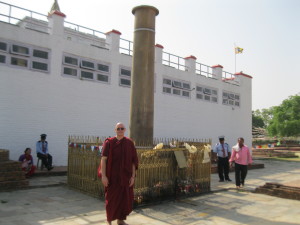 “The Maya Devi Temple that is constructed around the spot where Gotama was born has a very sanctified feeling that instilled a stillness and a sense of reflection within me. There is still some excavation being done inside the Temple as they are still discovering things as time goes on. When Emperor Asoka visited the site in 249 BC a pillar was erected with engravings in Brahmi script and Pali language that stated that this is the birthplace of Shakyamuni Buddha. Our first day we just remained inside the complex as even with a car it took us all day to see everything.
“The Maya Devi Temple that is constructed around the spot where Gotama was born has a very sanctified feeling that instilled a stillness and a sense of reflection within me. There is still some excavation being done inside the Temple as they are still discovering things as time goes on. When Emperor Asoka visited the site in 249 BC a pillar was erected with engravings in Brahmi script and Pali language that stated that this is the birthplace of Shakyamuni Buddha. Our first day we just remained inside the complex as even with a car it took us all day to see everything.
“On Friday we visited the surrounding areas of Lumbini. First we went to Kapilavastu which is the palace the Buddha had spent the 29 years before leaving on His search for the end to suffering. Next we drove to Kudan which is a significant place for four reasons: it is where the Buddha met His father for the first time since leaving; it is where His stepmother Prajapati offers the Buddha a robe; it is where His wife Yasodhara invites Him for a meal; and it is where Shariputtra ordains Rahula, the Buddha’s son. We then drove to nearby Gotihawa where we visited another Asoka Pillar that marks the site where Krakuchhanda Buddha, attained nirvana. We then traveled to Niglihawa to see another Asoka Pillar marking Kanakamuni Buddha’s birthplace. Next we made our way to Ramagrama where the Koliyas had enshrined the eight parts of the Buddha’s relics they had received in a magnificent stupa. Emperor Asoka on his visit here wanted to obtain the Buddha’s relics to build eighty four thousand minor stupa’s throughout his vast empire. However, the emperor did not touch the precious relics out of the request made by the Dragon King and the people of Ramagrama.
“As you can see, there is much more to Lumbini than just the birthplace of Gotama. The day being spent, we decided to make our way back to the hotel. We discussed our plans about leaving and returning to Kathmandu and had to decide between two choices: spend one more night in Lumbini and depart around 7-8am the next morning and arrive in Kathmandu at around 3-4pm, or take the “RedEye” that leaves that evening at about 8pm and arrives in Kathmandu at 5am the next morning. Traveling that night would take several hours longer since the driver would have to stop and rest for a couple of hours, but being nighttime it would be cooler and not so warm. We decided to leave that evening so we could be back at the Temple around 6am the next morning.
“Three hours before we were to leave a very strong storm was blowing into Lumbini. Very strong wind gusts between 20-30mph was accompanied by spectacular lightning that would light up the whole sky in this little rural area of Nepal. Only a small amount of rain was produced by this storm, but the heavy gusts of wind dropped the warm temperature down to very comfortable level. As we were waiting for our bus it became later and later. We were told that the bus was running about 45 minutes late, but it is on the way. A bus approached but was not ours, so we still had to wait for another 20 minutes. We finally boarded our bus and started to make our way back to Kathmandu but were sidetracked several miles into our journey. The bus that had left before ours was hit by a falling tree that was uprooted by a wind gust from the storm. We stopped to take on all the passengers that our bus could handle and continued on. I thought nothing of the random occurrence.
“We arrived in Kathmandu a little after 5am. We needed to catch a taxi from the bus station to the Temple in Lalitpur which is about a 20 minute ride. Being at the bus station and adding to the concept of convenient demand, the taxis were all overpriced. We decided to walk down the road until we could get a reasonably priced taxi, so we started to walk in the direction of Lalitpur. A few yards into our walk we passed a small butcher shop that could not be seen until you were right in front of it. I walked right past a goat that the butcher had killed that morning to sell to people that day. The goat was hanging upside down from it’s hind legs with the head, insides, and coat already removed just waiting for the butcher to divide it into sections and pieces to sell to customers. Coming up on this sight in that instant somewhat surprised me for a brief second. We found a taxi a few minutes later and headed for the Temple. About 1 minute into the taxi ride we passed what seemed like a freshly dead dog in the middle of the road and a intense feeling of uneasiness came upon me. I understand the concept of coincidences and how the mind can play tricks on you, but this feeling was different. I thought that seeing one dead animal is just a random occurrence, but for me to see two different freshly killed animals within five minutes was maybe more than just a coincidence. I told the other monk that something is wrong; something doesn’t feel right. He asked, “ what do you mean? ” I said seeing two dead animals like this within five minutes is not common for me and I have a bad feeling about it. He laughed as we approached a detour and then the taxi driver seemed to ask him for directions, so he started giving the driver directions in their native language. With this uneasiness still with me I thought about the previous night with the storm and the tree falling on the bus. Then I remembered when we left for Lumbini and the fatal event we passed with the bus going over the side of the cliff that killed dozens of people. I did not know what to think about these things and this feeling that I was experiencing, but at that moment we arrived at the Temple at 6:30 am on April 25th and these thoughts and feelings left my mind as all I wanted to do was take a shower. At 11:45 am that morning a magnitude 7.8 earthquake struck the Kathmandu valley killing almost 9,000 people.”
Disciple Bhikkhu Gunaratana
Go to Flckr and the Holy Vajrasana website
for more photos.

